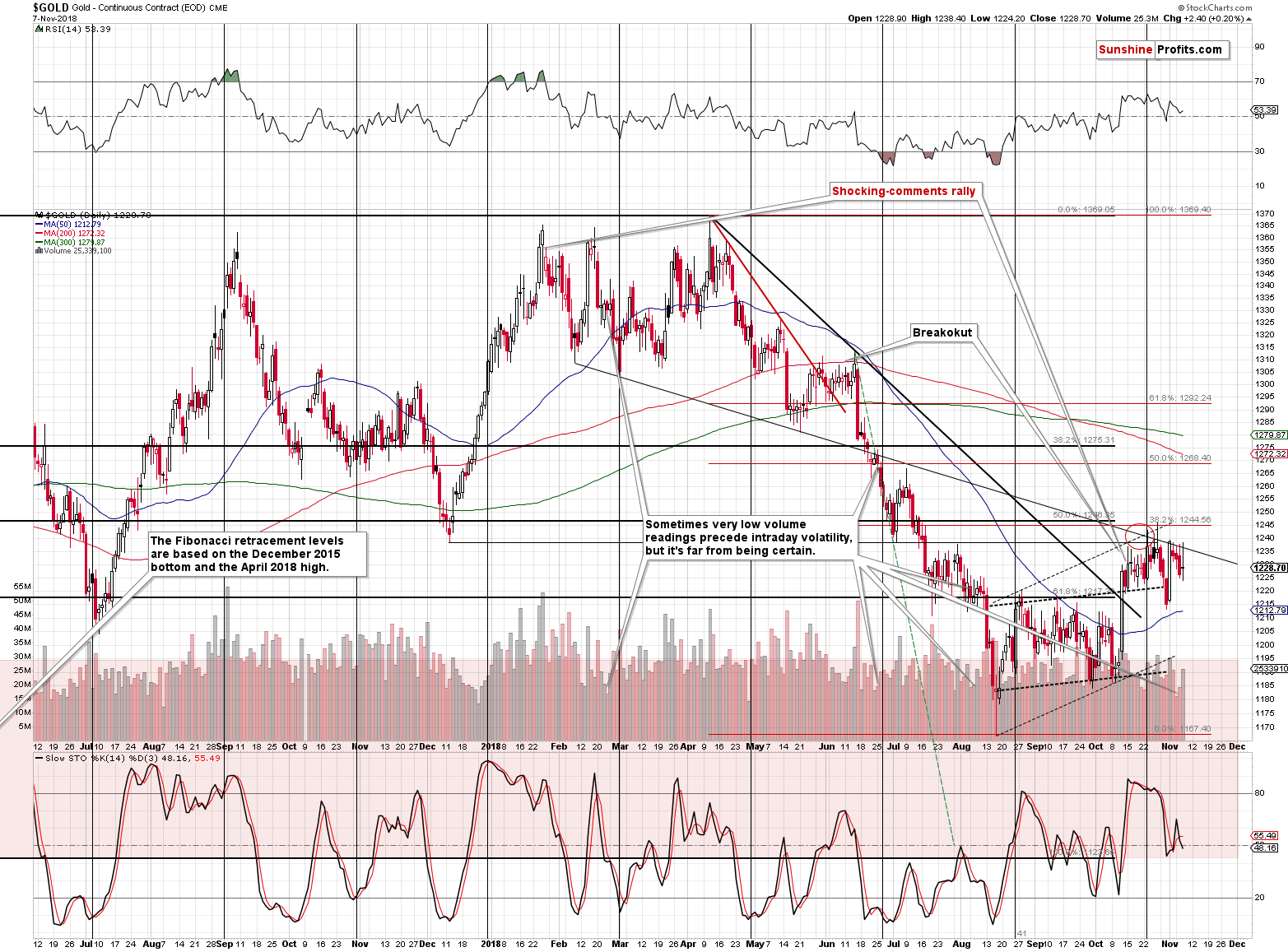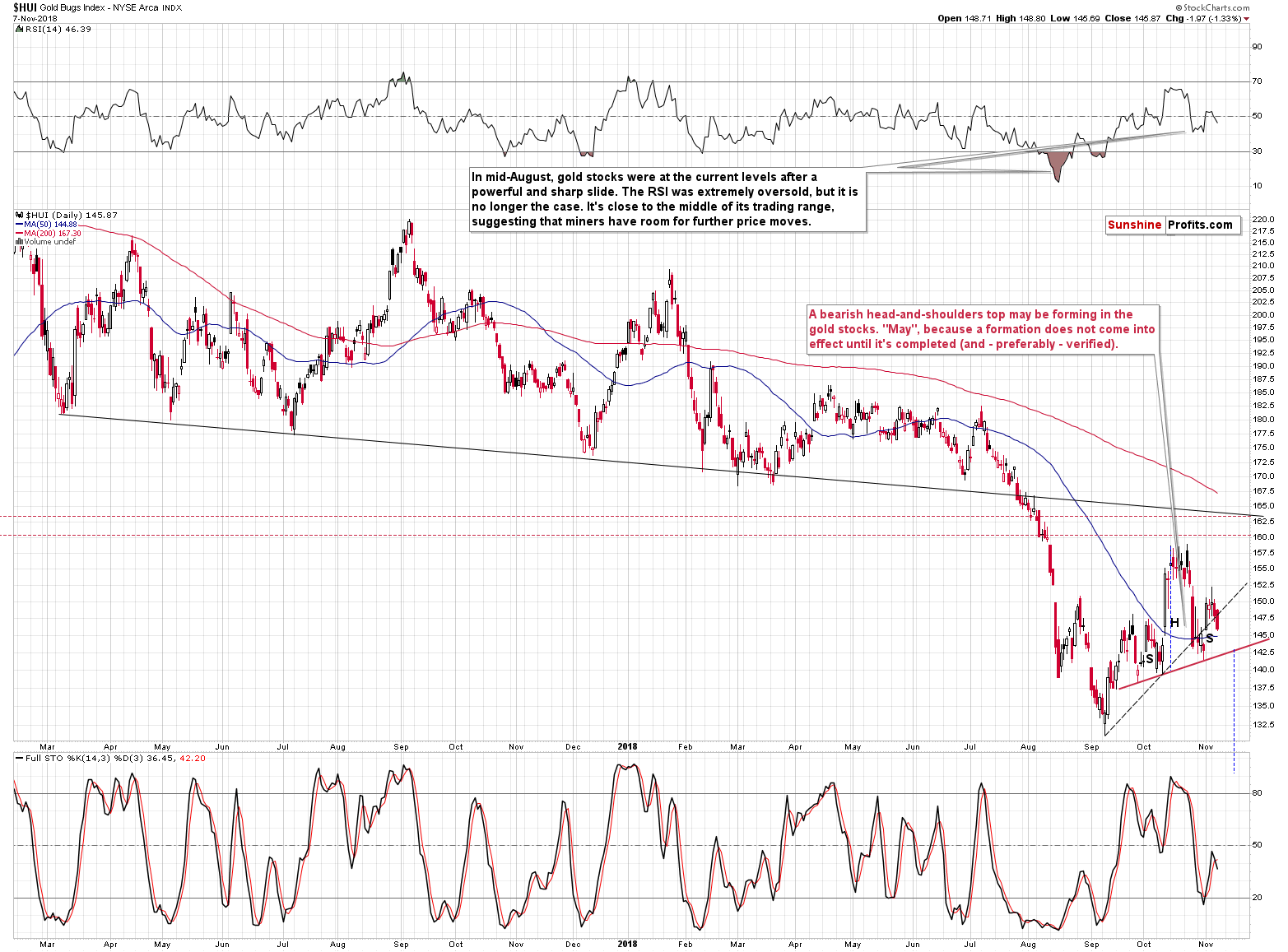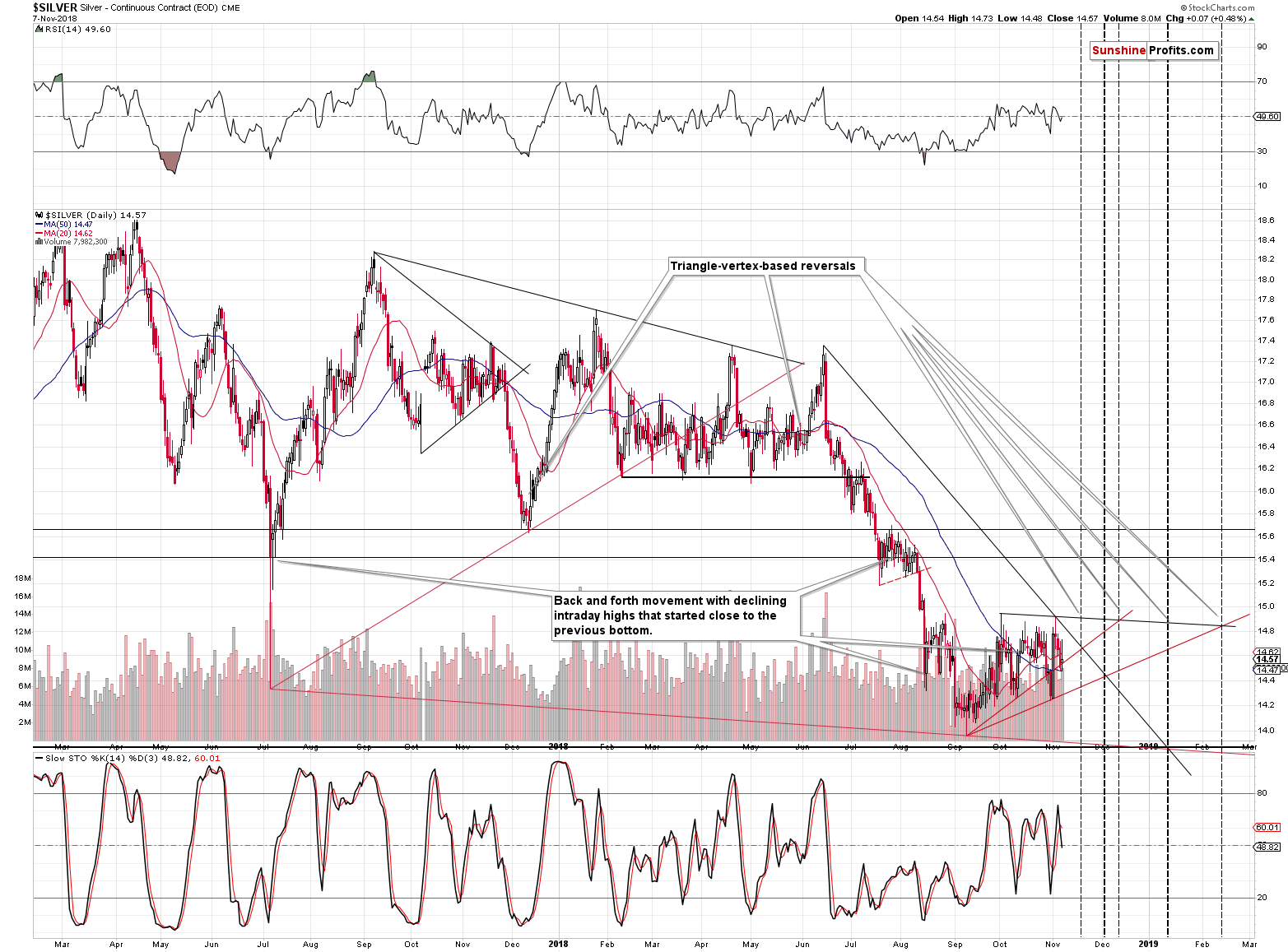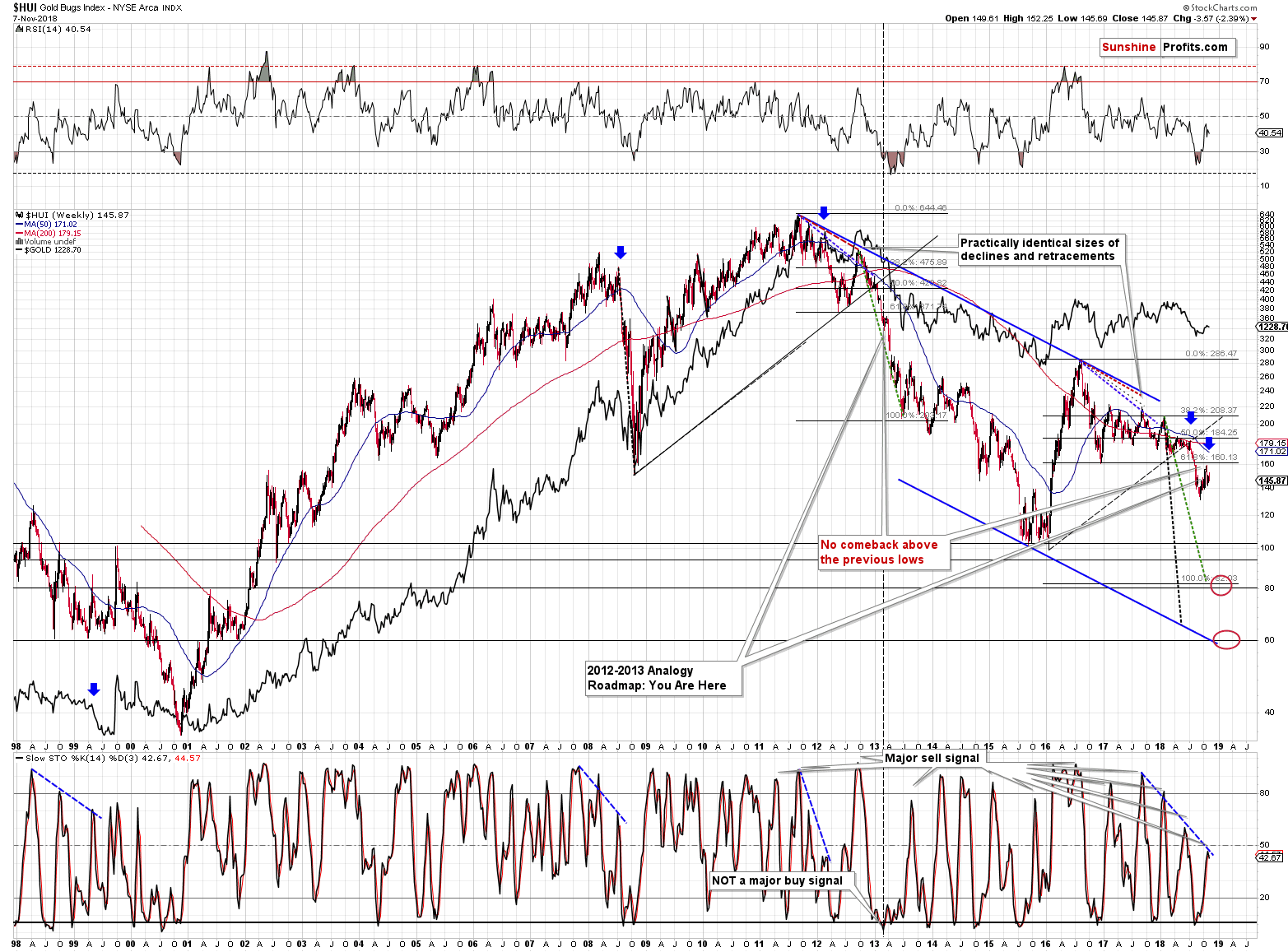Briefly: in our opinion, full (250% of the regular size of the position) speculative short positions in gold, silver and mining stocks are justified from the risk/reward perspective at the moment of publishing this alert.
The US elections are over and the post-election reactions are getting calmer. It’s not yet fully back to business in case of the precious metals market, but there are strong signs (especially from the gold mining stocks) suggesting that the gears are starting to turn. The time for one to position oneself before the next big move is almost over.
We’ve been describing the likely outcome for many weeks and nothing changed recently. Consequently, we trust that you are prepared for the upcoming decline in the precious metals sector.
Let’s take a look at the confirmations that we just saw, starting with the short-term ones.
Gold’s Reversal
Gold reversed on volume that was above average, which is a somewhat bearish sign. What’s much more bearish is that gold still ended the session $2 higher and gold stocks declined over 1%.
Gold Miners’ Weakness
The HUI Index was down by almost 2 points – 1.33%. That’s not much on a stand-alone basis, but it’s a big decline if we consider the fact that gold miners should have rallied – gold ended higher and the general stock market soared. And yet, gold stocks declined. It’s a clear and strong bearish sign.
We recently wrote a lot about the incomplete inverse head-and-shoulders pattern in gold and we made some of those comments available publicly. But, to be honest, we don’t expect our analysis to change minds of either gold promoters or the analysts that don’t pay attention to details.
Vision vs. Facts
In his book Thinking, Fast and Slow, the Nobel-prize laureate, Daniel Kahneman is explaining that when people have to choose between the vision that they have for something that is based on (what they view as) coherent signals, and between obvious facts that contradict their vision, they will choose the initial vision and ignore the facts. This effect is stronger if the vision is clearer and signals appear more coherent. A very short way to put it would be to say “my mind’s made up; don’t confuse me with facts”.
In case of the precious metals market, you have multiple sources that will want to confirm the bullish outlook for gold simply because they can either sell their gold and silver to you, or they can sell their analyses. The bias of the former seems self-explanatory, but the latter requires an explanation.
They – the other analysts – know that, because we know that, and they have access to the same statistics. The point is that on average, investors and traders don’t want to hear that something is going to decline, especially if they have invested in it, or want to invest in it. This means that they will want to buy the analyses that are bullish, and they will be reluctant to buy the analyses that dare to be bearish. And they will not want to purchase anything that is bearish on average. We know that based on the reactions to various types of analyses, ads, e-mail titles etc. we create.
The above means that analysts know that they are being rewarded for being bullish and are being punished for being bearish. What does that lead to? We reviewed the free precious metals analyses that are available and almost all of them are bullish. And this is despite the huge number of bearish factors that we presented (and made available publicly) in the previous weeks. You – our subscribers – are being informed first and are being updated whenever the situation requires it, but from time to time we’re doing the public service (this also serves as a sample of what we provide to you, our subscribers) and are providing information on some of the factors publicly.
And… The number of bullish factors that is presented is smaller than the number of bearish factors that we (alone) provided in the previous weeks. It’s important to note that we discuss the factors that appear bullish at the first sight, explaining and proving why they actually don’t make the outlook bullish, while the bullish camp just ignores the bearish factors, pretending they are not there.
Investors and analysts are being provided with facts and signals and they choose to ignore them. Why? Because their bullish vision is too coherent for them to be willing to accept that it may be incorrect.
Naturally, it would be easy to say the same about our analyses – why are we sticking to the bearish outlook? Is it because of the above-mentioned bias? The difference is that we don’t ignore the signals that are presented as bullish. Conversely, we welcome criticism and are happy to discuss the bullish factors. In fact, we want to test our views against adverse indications. If our initial analysis fails to hold in light of new factors, it’s time to drop it, adjust the outlook and investment / trading positions accordingly, and prepare to benefit from the move that appears most likely based on the most up-to-date analysis.
The objectivity, care, and openness to change is what creates value for investors. Being biased is what destroys value, even if it is disguised as “staying strongly bullish during tough times”.
And us? We’re taking the road much less travelled. The analysis needs to be done as objectively as possible and investors’ real interest has to come first. That’s why we will continue to describe things exactly as we see them, with as much objectivity as possible, utilizing diligence and great care, even if it comes at our own expense.
We admit; that was a rather long digression. The reason that we mentioned the incomplete inverse head-and-shoulders in the first place was that we have an incomplete (!) head-and-shoulders in golds stocks. It doesn’t have any implications yet, but if completed, it will have a target below 130, meaning a clear break to new 2018 lows. The funny thing is that if one wants to view incomplete H&S patterns as meaningful, then the bearish implications are currently even stronger.
Silver’s Short-term Reversals
We don’t have any new implications to discuss as far as the silver market is concerned, but we created several triangle-vertex-based reversal points based on the short- and medium-term lines and we wanted to share them. The long-term ones that we had featured previously are more important, but it will be useful to watch the short-term reversal as well. They might be useful as a confirmation of other signals.
Let’s move back to gold stocks, this time looking at them from the long-term perspective.
Epic Sign from the Gold Stocks
The week is not over yet, so it’s too early to say that this will be the case with 100% certainty, but unless the HUI Index rallies strongly, we will most likely get a sell signal from the weekly Stochastic indicator. This is a big deal, because this indicator confirmed major tops and preceded big price declines many times in the recent past. The signal has been particularly useful since 2011.
The other interesting thing is that we saw lower highs in the past several months and this is characteristic only for the biggest of the declines. We saw this kind of performance of the weekly Stochastic indicator in 1999, in 2008, and in 2012. The last two were obviously excellent times to exit the precious metals market, but the first one appears to be different.
And it was different, but not because of the regular factors. It was the Washington Agreement on Gold that caused gold to spike in 1999, taking the rest of the PM market with it. If it wasn’t for this spike, we would have likely seen a bottom in gold quite similar to what we saw in the gold stocks. The latter declined in a profound manner right after the spike. Consequently, if it wasn’t for the Washington Agreement, the precious metals sector would have most likely declined in a rather regular manner after the above-mentioned series of signals from the weekly Stochastic indicator.
Therefore, it seems justified to say that all 3 previous cases that are similar to what we see right now, have been followed by the biggest declines of the past 20 years.
Important Analyses
Before summarizing, we would like to emphasize that we have recently posted several analyses that are very important and that one should keep in mind, especially in the next several weeks. If you haven’t had the chance of reading them previously, we encourage you to do so today:
- Dear Gold Investor - Letters from 2013 - Analogy to 2013, which should make it easier to trade the upcoming sizable upswing (if enough factors point to it, that is) and to enter the market close to the final bottom.
- Gold to Soar Above $6,000 - discussion of gold’s long-term upside target of $6,000.
- Preparing for THE Bottom in Gold: Part 6 – What to Buy - extremely important analysis of the portfolio structure for the next huge, multi-year rally in the precious metals.
- Preparing for THE Bottom in Gold: Part 7 – Buy-and-hold on Steroids - description of a strategy dedicated to significantly boosting one’s long-term investment returns while staying invested in the PM sector.
- Gold’s Downside Target, Upcoming Rebound, and Miners’ Buy Plan - details regarding the shape of the following price moves, a buying plan for mining stocks, and a brief discussion of the final price targets for the current decline.
- Gold: What Happened vs. What Changed - discussion of the latest extreme readings from gold’s CoT report
- Key Factors for Gold & Silver Investors - discussion of key, long-term factors that support the bearish outlook for PMs. We are often asked what makes us so bearish – this article is a reply to this question.
- The Upcoming Silver Surprise - two sets of price targets for gold, silver and mining stocks: the initial and the final one.
- Precious Metals Sector: It’s 2013 All Over Again - comparison between 2013 and 2018 throughout the precious metals sector, the general stock market and the USD Index. Multiple similarities point to the repeat of a 2013-style volatile decline in the PMs.
- Changing One's Mind - Why, When, and How – discussing the way of analyzing the market that helps to stay focused on growing one’s capital while not being influenced by the loss aversion bias. This essay might be particularly useful in light of the recent upswing in the PMs.
- Inverse H&S Patterns and Something Even More Extreme - gold targets for the current decline in terms of price and time.
E-mail Notification Information
As you know, whenever we are posting a regular Alert, we are sending a notification about it via e-mail. However, we would like to make sure that everyone knows that it’s just a notification, and not the Alert itself (the intraday messages are usually copies of the Alert that is posted on the website) and that it can be accessed online even without the use of the e-mail. In the vast majority of cases, our e-mail will be received normally (we put a lot of effort into keeping the high deliverability of our messages), but at times you may still not get the notification to your e-mail inbox. In order to maximize the chance of receiving it, we suggest that you add us ([email protected]) to your address book / safe-senders list and that you make sure that your e-mail inbox has enough free space to receive new messages. Moreover, please note that you can always check the Alerts section on the website for new Alerts and access them using your login details.
We were recently contacted by one of our subscribers (hello Ali) via e-mail with information that our notification messages are no longer appearing in the inbox. We investigated, and it turns out that we are receiving e-mail bounces that say that the e-mail inbox is full. We tried replying to this e-mail, but our reply also bounced, and since we don’t have a phone number in this specific case, there’s not much more that we can do – except for posting a message over here, right in the Alert.
Summary
Summing up, the outlook remains strongly bearish for the precious metals sector. The current back and forth trading is tiring, and/or boring depending on one’s perspective (tiring from the short-term perspective, and boring from the long-term one), but it’s very likely that the patience here will be well rewarded. Gold’s very weak reaction to yesterday’s intraday decline in the USD suggests that we will likely not have to wait much longer, especially that we just got a confirmation from the mining stocks’ underperformance.
As always, we’ll keep you – our subscribers – informed.
To summarize:
Trading capital (supplementary part of the portfolio; our opinion): Full short positions (250% of the full position) in gold, silver and mining stocks are justified from the risk/reward perspective with the following stop-loss orders and exit profit-take price levels:
- Gold: profit-take exit price: $1,062; stop-loss: $1,257; initial target price for the DGLD ETN: $82.96; stop-loss for the DGLD ETN $49.27
- Silver: profit-take exit price: $12.72; stop-loss: $15.76; initial target price for the DSLV ETN: $46.97; stop-loss for the DSLV ETN $27.37
- Mining stocks (price levels for the GDX ETF): profit-take exit price: $13.12; stop-loss: $20.83; initial target price for the DUST ETF: $80.97; stop-loss for the DUST ETF $27.67
Note: the above is a specific preparation for a possible sudden price drop, it does not reflect the most likely outcome. You will find a more detailed explanation in our August 1 Alert. In case one wants to bet on junior mining stocks’ prices (we do not suggest doing so – we think senior mining stocks are more predictable in the case of short-term trades – if one wants to do it anyway, we provide the details), here are the stop-loss details and target prices:
- GDXJ ETF: profit-take exit price: $17.52; stop-loss: $31.23
- JDST ETF: initial target price: $154.97 stop-loss: $51.78
Long-term capital (core part of the portfolio; our opinion): No positions (in other words: cash)
Insurance capital (core part of the portfolio; our opinion): Full position
Important Details for New Subscribers
Whether you already subscribed or not, we encourage you to find out how to make the most of our alerts and read our replies to the most common alert-and-gold-trading-related-questions.
Please note that the in the trading section we describe the situation for the day that the alert is posted. In other words, it we are writing about a speculative position, it means that it is up-to-date on the day it was posted. We are also featuring the initial target prices, so that you can decide whether keeping a position on a given day is something that is in tune with your approach (some moves are too small for medium-term traders and some might appear too big for day-traders).
Plus, you might want to read why our stop-loss orders are usually relatively far from the current price.
Please note that a full position doesn’t mean using all of the capital for a given trade. You will find details on our thoughts on gold portfolio structuring in the Key Insights section on our website.
As a reminder – “initial target price” means exactly that – an “initial” one, it’s not a price level at which we suggest closing positions. If this becomes the case (like it did in the previous trade) we will refer to these levels as levels of exit orders (exactly as we’ve done previously). Stop-loss levels, however, are naturally not “initial”, but something that, in our opinion, might be entered as an order.
Since it is impossible to synchronize target prices and stop-loss levels for all the ETFs and ETNs with the main markets that we provide these levels for (gold, silver and mining stocks – the GDX ETF), the stop-loss levels and target prices for other ETNs and ETF (among other: UGLD, DGLD, USLV, DSLV, NUGT, DUST, JNUG, JDST) are provided as supplementary, and not as “final”. This means that if a stop-loss or a target level is reached for any of the “additional instruments” (DGLD for instance), but not for the “main instrument” (gold in this case), we will view positions in both gold and DGLD as still open and the stop-loss for DGLD would have to be moved lower. On the other hand, if gold moves to a stop-loss level but DGLD doesn’t, then we will view both positions (in gold and DGLD) as closed. In other words, since it’s not possible to be 100% certain that each related instrument moves to a given level when the underlying instrument does, we can’t provide levels that would be binding. The levels that we do provide are our best estimate of the levels that will correspond to the levels in the underlying assets, but it will be the underlying assets that one will need to focus on regarding the signs pointing to closing a given position or keeping it open. We might adjust the levels in the “additional instruments” without adjusting the levels in the “main instruments”, which will simply mean that we have improved our estimation of these levels, not that we changed our outlook on the markets. We are already working on a tool that would update these levels on a daily basis for the most popular ETFs, ETNs and individual mining stocks.
Our preferred ways to invest in and to trade gold along with the reasoning can be found in the how to buy gold section. Additionally, our preferred ETFs and ETNs can be found in our Gold & Silver ETF Ranking.
As a reminder, Gold & Silver Trading Alerts are posted before or on each trading day (we usually post them before the opening bell, but we don't promise doing that each day). If there's anything urgent, we will send you an additional small alert before posting the main one.
=====
Latest Free Trading Alerts:
US mid-term elections are behind us. Surprisingly, both parties won! How is it possible? Let’s read our article and find out! We will also explain what the election results imply for the world and the gold market.
Wednesday's trading session was very bullish, as stocks accelerated their short-term uptrend following the U.S. Elections outcome. The S&P 500 index got back above the level of 2,800. The market is at its mid-October local high. So, will it continue higher or reverse downwards here?
Stocks Breaking Higher, but Resistance Ahead
=====
Thank you.
Sincerely,
Przemyslaw Radomski, CFA
Editor-in-chief, Gold & Silver Fund Manager
Gold & Silver Trading Alerts
Forex Trading Alerts
Oil Investment Updates
Oil Trading Alerts







